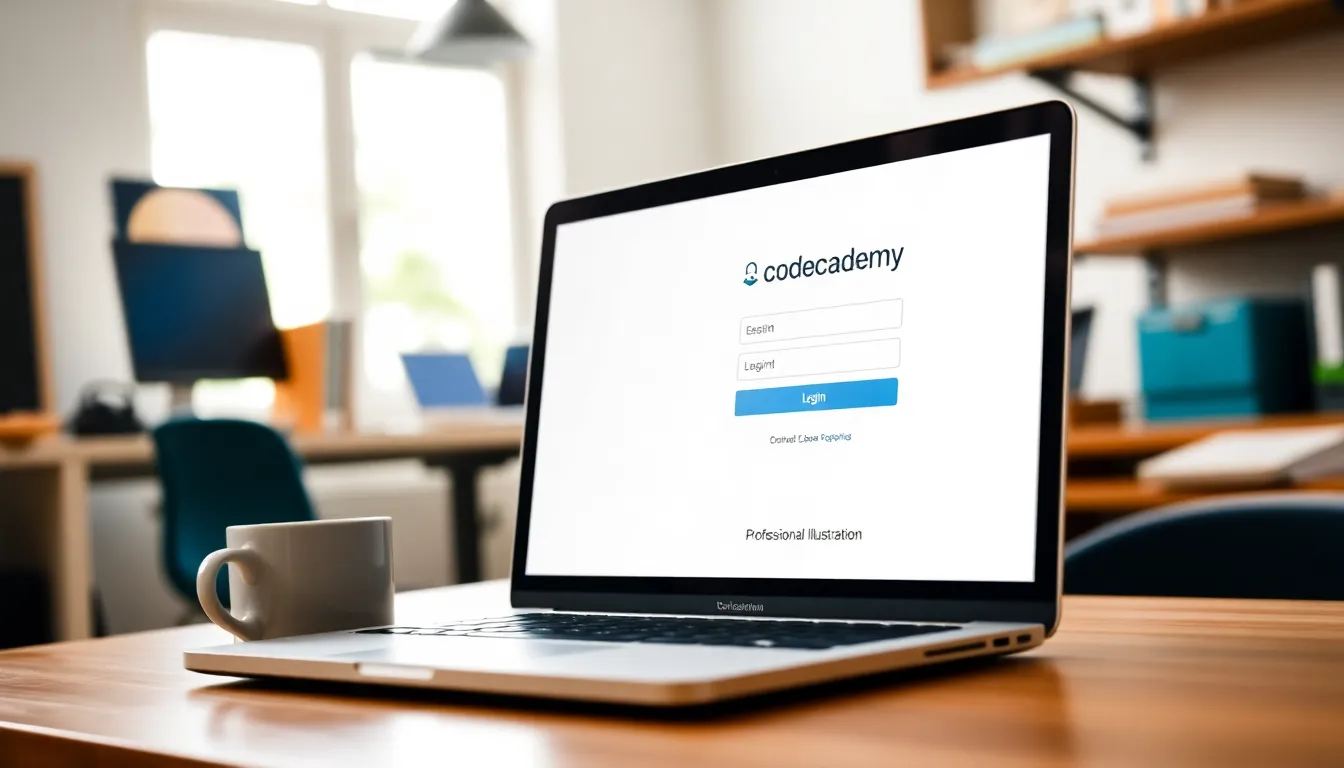In a world where coding skills can open doors to endless opportunities, Codecademy stands out as a beacon of learning. Whether you’re a curious beginner or a seasoned pro looking to sharpen your skills, accessing your Codecademy account is the first step on your coding journey. But let’s face it—navigating the login process can feel like trying to decode a secret language.
Table of Contents
ToggleUnderstanding Codecademy Login
Accessing a Codecademy account is essential for a smooth learning experience. The login process serves as a vital gateway to coding resources, courses, and community support.
Importance of Having an Account
Having an account on Codecademy enhances the learning journey significantly. Users can track their progress, save course completion status, and revisit lessons anytime. Personalized learning is possible, allowing users to receive tailored content recommendations based on their interests. Community engagement benefits users by providing access to forums where they can connect with fellow learners and instructors. An account also unlocks advanced features, such as quizzes and projects, crucial for practical application of coding skills.
Creating Your Codecademy Account
Creating a Codecademy account is a straightforward process. First, users visit the Codecademy website and click on the sign-up button. Options for signing up include using an email address or connecting through social media accounts like Google or Facebook. After choosing a method, users fill out required fields and confirm their email address through a verification link. Setting a password that meets security standards ensures account protection. Once the setup is complete, users can log in and begin exploring the various coding courses available.
Accessing Codecademy

Accessing Codecademy requires a few simple steps for a smooth login experience. Users must enter their credentials to gain entry to a wealth of coding resources.
Steps to Login
- Navigate to the Codecademy website.
- Click on the “Log In” button located at the top right corner.
- Input the registered email address.
- Type in the corresponding password.
- Select the “Log In” option to access the account.
Completing these steps allows users to enter their Codecademy dashboard and start learning.
Troubleshooting Login Issues
Experiencing login issues can hinder the learning process. Ensure that the entered email and password match the registered credentials. For forgotten passwords, utilize the “Forgot Password?” link to receive a reset email. Check the inbox for this email and follow the provided link.
Clearing the browser cache can also resolve various login problems. If issues persist, switching to a different browser or device often proves effective.
Features Available After Login
After logging into Codecademy, users access a range of features designed to enhance their learning experience.
Course Progress Tracking
Users can monitor their course progress in real-time. Tracking systems display completion percentages and highlight milestones achieved. A visual representation of skills mastered guides learners through their programming journeys. Users can revisit previously completed lessons or revisit challenging topics to reinforce understanding. Access to progress reports helps individuals identify strengths and areas needing improvement. Built-in reminders encourage consistent learning habits, helping users stay on track toward their learning goals.
Community Engagement
Engagement with the Codecademy community offers numerous benefits. Users can participate in forums to ask questions or seek advice from fellow learners. Connecting with others fosters collaboration and promotes knowledge sharing. Community leaders often host events and discussions to facilitate learning opportunities. Additionally, learners can share their projects for feedback, contributing to personal growth and skills enhancement. Access to live events and webinars allows users to stay updated on industry trends. Connecting with like-minded individuals enriches the overall learning experience.
Security Tips for Your Account
Securing your Codecademy account helps protect personal information and progress. Implementing strong security measures is essential for a safe learning experience.
Strong Password Practices
Creating a strong password serves as the first line of defense. Utilize a mix of uppercase and lowercase letters, numbers, and special characters for added strength. Aim for a minimum length of 12 characters. Avoid using easily guessable information like birthdates or common words. Regularly updating the password enhances security. It’s prudent to use unique passwords across different platforms to minimize risk. Consider using a password manager to store and generate secure passwords.
Enabling Two-Factor Authentication
Activating two-factor authentication adds an extra layer of security to the account. This feature requires a second verification step, usually through a mobile app or SMS code. Codecademy provides the option to enable this feature within account settings. Users receive a notification whenever there’s an attempted login from an unrecognized device. Maintaining this practice significantly reduces the likelihood of unauthorized access. Always review account activity to ensure no suspicious logins occur.
Accessing a Codecademy account is a crucial step for anyone embarking on their coding journey. With a seamless login process users can unlock a wealth of resources that enhance their learning experience. The platform not only allows for progress tracking but also fosters community engagement through forums and collaborative projects.
By following security best practices users can protect their accounts and ensure a safe environment for their educational pursuits. Embracing these features and maintaining account security will empower learners to make the most of their Codecademy experience.



